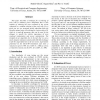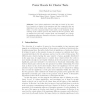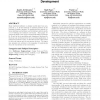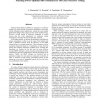1419 search results - page 14 / 284 » Power Droop Testing |
ISVLSI
2003
IEEE
14 years 3 months ago
2003
IEEE
This paper describes a technique for re-ordering of scan cells to minimize power dissipation that is also capable of reducing the area overhead of the circuit compared to a random...
RECOMB
2005
Springer
14 years 10 months ago
2005
Springer
Abstract. Gene cluster significance tests that are based on the number of genes in a cluster in two genomes, and how compactly they are distributed, but not their order, may be mad...
WISER
2004
ACM
14 years 3 months ago
2004
ACM
Many hardware/software co-design models have been proposed [7, 2, 5, 6] that attempt to address problems in the hardware/software interface, in partitioning the system between har...
ETS
2007
IEEE
13 years 11 months ago
2007
IEEE
Software-Based Self-Test (SBST) has emerged as an effective strategy for on-line testing of processors integrated in non-safety critical embedded system applications. Among the mo...
ICCD
2006
IEEE
14 years 6 months ago
2006
IEEE
—X-filling is preferred for low-capture-power scan test generation, since it reduces IR-drop-induced yield loss without the need of any circuit modification. However, the effecti...




